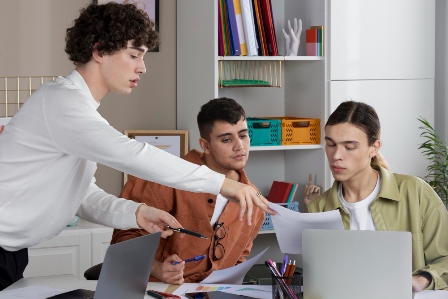In this comprehensive article, we will explore the multifaceted role of the Department of Labor (DOL) and how it contributes to ensuring the well-being of American workers. We will delve into the various functions and responsibilities of this crucial government agency, shedding light on its pivotal role in safeguarding labor rights, promoting safe working conditions, and fostering a strong and stable workforce.
The Department of Labor (DOL) plays a pivotal role in shaping the American workforce by upholding labor standards, ensuring workers’ rights, and fostering safe working environments. In this article, we will embark on a journey through the various facets of the DOL, exploring its rich history, mission, and functions. From wage regulations to workplace safety, and from international labor relations to labor statistics, the DOL’s reach is extensive and its impact profound.
The Department of Labor: An Overview
Historical Background
The Department of Labor was established in 1913 and became an official cabinet-level agency in 1913. Its inception marked a significant step towards recognizing the importance of labor issues in the United States.
Mission and Vision
The DOL’s mission is to foster, promote, and develop the well-being of wage earners, job seekers, and retirees. It seeks to improve working conditions, protect employee benefits, and help people find jobs. The DOL envisions an America where workers’ rights are safeguarded, and everyone has access to opportunities for employment and economic security.
Ensuring Fair Labor Practices

Wage and Hour Standards
The DOL enforces wage and hour standards, including minimum wage, overtime pay, and recordkeeping. This ensures that employees receive fair compensation for their work.
Child Labor Regulations
Child labor laws are designed to protect the rights and safety of young workers, setting restrictions on the type of work, hours, and conditions in which minors can be employed.
Promoting Safe and Healthy Work Environments
Occupational Safety and Health Administration (OSHA)
OSHA is responsible for creating and enforcing regulations to ensure that workplaces are safe and free from hazards that could harm employees. It conducts inspections and provides guidelines to maintain workplace safety.
Workers’ Compensation
Workers’ compensation programs provide financial and medical benefits to employees who are injured or become ill due to their work. The DOL oversees and administers these programs.
Empowering Workers through Training and Development

Workforce Investment Act (WIA)
WIA programs support workforce development by offering training and employment services to job seekers, ensuring they have the skills and knowledge needed for today’s job market.
Apprenticeship Programs
The DOL promotes apprenticeship programs that provide hands-on training and employment opportunities for individuals seeking to enter skilled trades and professions.
Combating Workplace Discrimination
Office of Federal Contract Compliance Programs (OFCCP)
OFCCP ensures that federal contractors and subcontractors do not discriminate based on race, color, religion, sex, sexual orientation, gender identity, national origin, disability, or veteran status.
Equal Employment Opportunity (EEO)
The EEO enforces laws against workplace discrimination, fostering equal opportunities and fair treatment for all employees, regardless of their background.
Navigating Labor Market Challenges
Unemployment Insurance
Unemployment insurance offers financial support to workers who lose their jobs through no fault of their own. It assists them during their job search and provides temporary relief.
Labor Market Information
The DOL collects and provides labor market information, helping job seekers make informed decisions about their careers and assisting employers in making hiring and expansion decisions.
Supporting Disadvantaged Workers
Job Corps
Job Corps offers education and training to disadvantaged young people, helping them acquire skills and find employment or further their education.
Work Opportunity Tax Credit (WOTC)
WOTC provides tax incentives to employers who hire individuals from certain target groups, such as veterans, ex-felons, and people receiving public assistance.
International Labor Relations
Labor Standards in Global Trade
The DOL plays a role in ensuring that trade agreements consider and protect workers’ rights and labor standards.
Bureau of International Labor Affairs (ILAB)
ILAB promotes workers’ rights internationally, supporting programs and initiatives that improve labor conditions globally.
Labor Statistics and Research
Bureau of Labor Statistics (BLS)
BLS provides vital labor statistics, including employment data, wages, and economic indicators, to help policymakers and the public make informed decisions.
Research and Analysis
The DOL conducts research and analysis to understand labor market trends, emerging issues, and the impact of policies on workers and employers.
The Department of Labor’s Impact on Society
The DOL’s multifaceted functions impact American society by safeguarding workers’ rights, fostering safe working conditions, and promoting a strong and stable workforce. Its mission is an essential component of ensuring social and economic well-being.
Frequently Asked Questions
Here are some FAQs related to What Does The Department OF Labor Do
The main function of the Department of Labor is to foster, promote, and develop the well-being of wage earners, job seekers, and retirees in the United States. It works to improve working conditions, safeguard labor rights, enforce wage and hour standards, and ensure that workplaces are safe and free from hazards. The DOL’s core mission is to empower workers and job seekers, supporting their economic security and providing access to employment opportunities.
The US Department of Labor investigates a wide range of labor-related issues. Some of the key areas it investigates include wage and hour violations, workplace safety and health concerns, workplace discrimination, child labor violations, and compliance with labor laws, especially by federal contractors. The department also conducts research and analysis to understand labor market trends and emerging issues.
The Department of Labor seal is a symbol that represents the mission and values of the department. It features an eagle holding a bundle of arrows and an olive branch, signifying both the department’s commitment to protecting workers’ rights and promoting peace and prosperity in the labor market. The seal encapsulates the DOL’s dedication to fostering a balanced and fair working environment in the United States.
The exact number of employees at the US Department of Labor may vary over time due to changes in administration, budgets, and staffing needs. To get the most current and accurate information on the department’s staffing levels, you should visit the official website of the Department of Labor or consult the latest government reports.
The Department of Labor has numerous responsibilities, but three of its primary responsibilities include:
Enforcing Labor Laws: The DOL enforces labor laws related to minimum wage, overtime pay, workplace safety, and anti-discrimination, ensuring that workers are treated fairly and equitably.
Promoting Workforce Development: The DOL supports workforce development by offering training and employment services to job seekers, helping them acquire skills and find employment.
Research and Data Collection: The DOL collects and provides labor market information and conducts research to understand labor market trends, emerging issues, and the impact of policies on workers and employers.
The Secretary of Labor is the head of the US Department of Labor. The Secretary is a member of the President’s cabinet and is responsible for overseeing the department’s operations, enforcing labor laws, and implementing policies related to labor and employment. Please check the most recent government sources or the official Department of Labor website for the current Secretary of Labor and any updates in leadership.
Conclusion
The Department of Labor is a cornerstone of workers’ rights and labor standards in the United States. It plays a multifaceted role, from ensuring fair wages to promoting safe workplaces, supporting job training, and even influencing international labor relations. As we move forward, the DOL continues to adapt to the ever-changing landscape of the workforce, championing the rights and well-being of American workers.

